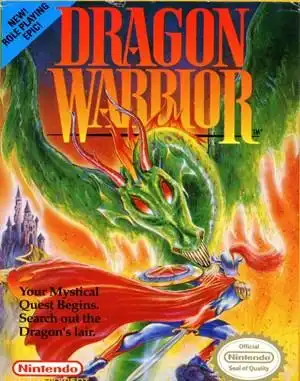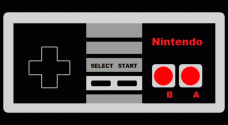Long before sprawling open worlds and cinematic cutscenes defined role-playing games, a simple 8-bit adventure arrived on the Nintendo Entertainment System, quietly laying the groundwork for everything that followed. That game was Dragon Warrior.
For many of us who grew up in the late '80s and early '90s, this wasn't just another cartridge; it was an introduction to a whole new type of game. A game where you weren't just jumping on Goombas or rescuing a princess from a castle – you were becoming a hero, exploring a vast (for the time) world, talking to townsfolk, battling monsters in turn-based combat, and getting stronger with every victory.
Let's dust off the cobwebs and take a nostalgic look back at the game that started it all for console RPGs in North America.
Stepping into Alefgard: The World and Exploration
From the moment you step out of Tantegel Castle, the world of Alefgard feels both dangerous and full of possibility. Unlike linear games of the era, Dragon Warrior presented you with a relatively open map. You weren't explicitly told where to go next, though hints from King Lorik and various townsfolk nudged you in the right direction.
The genius (and sometimes frustration) of the design was that enemy difficulty scaled with distance from the starting castle. Wander too far too soon, and you'd be quickly reminded that you weren't ready for the tougher monsters lurking in distant lands or deep dungeons. This simple mechanic created a genuine sense of exploration and progression – venturing into a new area felt like a real accomplishment.
Exploring towns involved talking to everyone (sometimes multiple times!), checking shops for better gear, and resting at inns. Dungeons added another layer, often requiring torches to see and featuring layouts that felt genuinely maze-like back then.
Turn-Based Titans: Combat and Grinding
Combat in Dragon Warrior is the definition of straightforward: it's one-on-one. You face a single monster at a time, choose from commands like Fight, Run, Spell, or Item, and hope for the best. There's no party system, no complex strategies, just you, your sword (or club), and your limited magic spells against a parade of iconic Akira Toriyama-designed monsters.
Yes, the combat is simple, and yes, it involves a lot of grinding. Gaining levels is essential to survive, and that means many, many random encounters. While this might feel tedious by today's standards, back then, it was part of the loop. Each level up felt significant, boosting your stats and bringing you one step closer to tackling that intimidating enemy you ran from earlier. It taught patience and persistence – core tenets of old-school RPGs.
Quests, Kings, and Quirks: Story and Systems
The plot is classic fantasy: you are a descendant of the legendary hero Erdrick, tasked with rescuing Princess Gwaelin and defeating the evil Dragonlord who has plunged the world into darkness. It's a simple premise, but effective. There's even a memorable moment where the Dragonlord makes you an offer... though taking it doesn't end well!
One of the most discussed aspects of the original NES Dragon Warrior is its interface and save system.
- The Menu: Interacting with stairs, doors, or even talking to people required opening a menu, selecting "Command," then the action (like "Door" or "Talk"), and then selecting the target. It was clunky, even for the time, but it was how you played, and you got used to it.
- Saving: Forget auto-save or save points. To save your progress, you had to trek all the way back to Tantegel Castle and speak with King Lorik. Get wiped out by a tough monster far from town? You'd lose half your gold and be sent back to the King, a harsh penalty that added genuine tension. (The North American version did thankfully add a battery save, replacing the Japanese password system, which was a huge quality-of-life improvement!).
These quirks are part of the game's identity. They were limitations of the hardware and design philosophy of the time, but overcoming them was part of the challenge and the charm.
Sounds and Sights: Retro Charm
Akira Toriyama's distinctive character and monster designs were a perfect fit for the game's whimsical-yet-serious tone. From the adorable Slimes to the imposing Golems, the pixel art was simple but effective and instantly recognizable.
Koichi Sugiyama's musical score, while limited by the NES sound chip, produced themes that have become iconic staples of the Dragon Quest series. The overworld theme, the battle music, the town melody – they burrowed into your brain and provided the perfect soundtrack for your epic quest. While later orchestral versions are undoubtedly richer, there's a raw, nostalgic quality to the original 8-bit tunes.
The Legacy Lives On: Why Dragon Warrior Still Matters
Dragon Warrior was a groundbreaking game for console players, especially in North America where the RPG genre was primarily a PC phenomenon. Nintendo famously gave away copies of the game with Nintendo Power subscriptions, introducing countless players to the genre.
It established fundamental elements that would become standard in console RPGs:
- Turn-based combat viewed from the player's perspective
- Overworld exploration with random encounters
- Towns with shops, inns, and NPCs offering hints
- Linear character progression through experience points and levels
- Collecting gear to increase power
- A clear main quest with smaller objectives
While it might feel primitive today, understanding Dragon Warrior is key to understanding the evolution of games like Final Fantasy, Phantasy Star, and countless others. It wasn't just a game; it was a template.
How to Revisit Alefgard Today
Feeling the urge to step back into the shoes of the legendary hero? The original NES cartridge can be pricey for collectors, but thankfully, Dragon Warrior (or Dragon Quest I, as it's now consistently called) is accessible in several ways:
- Remakes: The game has been remade multiple times, notably for the Super Famicom, Game Boy Color (packaged with Dragon Warrior II), mobile devices (iOS/Android), and the Nintendo Switch. These versions often feature updated graphics, streamlined interfaces, and quality-of-life improvements that make them much more approachable for modern players.
- Emulation/Digital: While the original NES version isn't widely available digitally on modern consoles, the remakes often are. For the truly adventurous, emulation options exist (like DOSBox for PC ports or various emulators for console versions), though legal availability varies. The GBC version is often cited as a great balance between old and new.
Experiencing Dragon Warrior today is less about cutting-edge gameplay and more about appreciating history. It's a playable artifact, a glimpse into the past that shaped the future of gaming.
Frequently Asked Questions
Q: Is Dragon Warrior the same as Dragon Quest? A: Yes! "Dragon Warrior" was the name used for the first four games in the series in North America due to a trademark conflict. Starting with Dragon Quest V, the series adopted its original Japanese name, "Dragon Quest," worldwide.
Q: Is the original NES Dragon Warrior hard to play now? A: By modern standards, yes. The interface is clunky, the combat is simple and repetitive (requiring significant grinding), and the save system is inconvenient. However, if you have patience and an appreciation for retro challenges, it's certainly playable. The remakes offer a much smoother experience.
Q: How long does it take to beat Dragon Warrior? A: The original game is relatively short for an RPG, typically taking anywhere from 10-20 hours depending on how much you grind and explore.
Conclusion
Dragon Warrior isn't just a game; it's a cornerstone of the console RPG genre. It introduced a generation to the thrill of leveling up, exploring vast worlds, and embarking on epic quests. While time has certainly added some dust to its mechanics, its historical importance and nostalgic charm remain undeniable. If you're a fan of RPGs, taking a trip back to Alefgard to see where it all began is an adventure well worth undertaking. It's a reminder that even with simple pixels and limited sound, a compelling journey and the promise of becoming a hero were all we needed.


